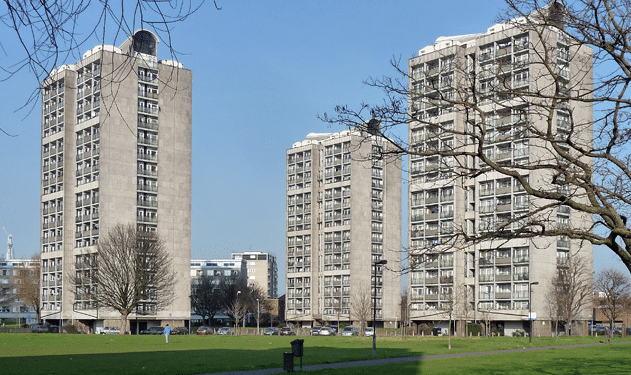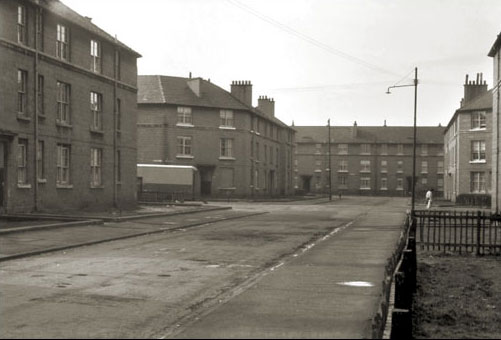Instead of concrete cancer in the sky looking like aliens in an episode of Dr Who or opportunites to label and stigmatise parts of the population

how about creating something to be proud of and treating people like humans and not cattle?
‘It’s almost as if treating people with kindness and respect works!’
This estate in Vienna reflects a relationship in which architects, designers and administrators have genuine respect for those they seek to house.
The best way to understand UK council estates is to apply sociological analysis. It would be fascinating to compare the below with Austrian sociologists and their analysis of their’s above.
Council estates: a symbol of failure?
It is clear that many see estates as a symbol of failure for everyone but particularly for those who live in them. Estate life forms a ‘wall in the head’ (Hanley, 2007, pp. 148–9), a particular state of mind producing a distinctive set of aspirations. These social psychological claims strongly parallel ideas that council estates generate their own subcultures that signal such places as different from others. This is also replicated by some journalists:
The truth is that council housing is a living tomb. You dare not give the house up because you might never get another, but staying is to be trapped in a ghetto of both place and mind. … The people in them need to have better training and more incentives to work. And council estates need to be less cut off from the rest of the economy and society.
It is not British civilisation that ails … It is British council estates. … We made them. Now we need to unmake them, doing whatever it takes.
(Hutton, 2007)
The context of Will Hutton’s assertions was a debate sparked by a series of murders of teenagers in estates in South London in early 2007. In making the generalisation that council estates are ghettos, he underestimates the degree of heterogeneity and internal social differentiation that exists within estates. Communities are very rarely undifferentiated in the way that Hutton implies (Mooney and Neal, 2009) and the suggestion that there is something approaching a ghetto or estate mentality reproduces stigmatising stereotypes of particular social groups, including among them some of the most deprived sections of society.
Council estates did not always carry the social stigma that is attached to them now. In the 1920s and 1930s and for a considerable time after the Second World War they met the acute housing needs of millions of people across the UK. It is important therefore that we historicise the idea of the ‘problem estate’. To help with this, let us consider briefly some important research conducted by sociologist Seán Damer in Glasgow in the 1970s and 1980s. Damer’s concerns lay with the history of a particular council estate in the Govan district of Glasgow. Constructed between 1934 and 1935 as one of the city’s many ‘rehousing’ estates (or ‘schemes’), the Moorepark scheme accommodated some of the families displaced through slum-clearance programmes. By the 1970s, the estate had come to achieve local and Glasgow-wide notoriety as an alleged locale of violence, drunkenness and assorted other social problems, and it was increasingly referred to by what became its better-known label, ‘Wine Alley’ (Damer, 1989).

Copyright © Sean Damer ©Figure 7 Moorepark housing scheme, Glasgow, early 1970s. This was typical of Glasgow’s 1930s’ ‘slum-clearance’ estates
The label ‘Wine Alley’ says much about the negative reputation attached to Moorepark. On the basis of interviews with tenants, housing and council officials, and police officers among others, and using detailed examination of archival records and reports produced by Glasgow Corporation and relevant Scottish Office departments from the 1930s, Damer was able to demonstrate how ideas of a ‘problem family’, ‘problem tenant’ and ‘problem estate’ first developed in the 1930s and not only came to apply to the residents of Moorepark but (especially in the post-1945 era) became more widespread as ways of representing particular sections of the council housing population.
Damer’s detailed research sought to locate the factors that would explain why this reputation had developed, and his work is important not least for the ways in which it illuminates the historical evolution of the ideas of problem people and problem places. Through this research he reminds us that contemporary negative representations are not recent developments but in significant ways are contemporary manifestations of historical processes. However, we need to be alert to some of the potential problems that can emerge in using historical evidence to develop the kinds of argument with which we are concerned in this course. It is important to avoid interpreting the rationales and meanings of policies from the past from the perspective of contemporary debates and arguments. One of the ways in which Damer avoids such a pitfall is by considering how the discourses of problem tenants and places came to be reinvented in the 1960s and 1970s (see also Johnstone and Mooney, 2007).
There is the further problem of what might be termed ‘hindsight’, the tendency to see past events as the unfolding of one story whereas there may be competing and conflicting stories. And we may only be able to generate partial understandings from the available historical evidence base. Not only is incomplete evidence open to different interpretations, but evidence can be selectively used depending on the larger story that the author wishes to convey or the argument being advanced. In attempting to frame historical evidence in terms of contemporary concerns and arguments, we need to allow for the possibility of other stories, meanings and understandings. However, properly located in the context of wider social and political developments at the time in question, historical evidence is invaluable in helping us understand some of the enduring legacies of the past that pervade images and representations of ‘problem’ people and places today.
In relation to the themes of this course, historical research helps us to uncover the continuities between the perceptions of problem places in Victorian Britain, notably the slums and rookeries of the late nineteenth-century city, the emergence of ‘problem estates’ in the post-1945 period, and more contemporary terms such as ‘sink’ estates, ‘hard-to-let’ estates, ‘inner-city’ and banlieue. While the historical circumstances which produced these neighbourhoods, and the terms generated to signify them, are different, there is a striking similarity in the purpose of the latter. These terms separate out the inhabitants of these ‘problem’ places from the ‘mainstream’ or ‘normal’ society – and ritually degrade, humiliate and blame them for their poverty and deprivation in the process. We also need to be alert to the international appeal and spread of the idea of problem places. Ideas and representations of problem places are not confined to European and North American contexts: they are also manifested in the ‘favelas’, ‘barrios’ and ‘ghettos’ that characterise many ‘Third World’ cities (Davis, 2006b; Neuwirth, 2006).
Given that such segregation and stigmatisation are central components of so many societies across the world, we may conclude that the idea of populations of problem places as somehow marginal to society is a myth. This ‘myth of marginality’ (Perlman, 1976) both presents people living in poverty as hopeless, deficient and disorganised masses surplus to society, and obscures the complex interrelations between different forms of economic activity. Stigmatisation of the kind highlighted in the work of Damer and others devalues the experiences, perspectives and voices of people who live in places regarded as problematic. People who live in banlieue estates, slums, shanty towns and disadvantaged council estates are still people, struggling to build their lives and to survive. In such localities a myriad of resourceful coping and ‘getting-by’ personal, household and community strategies emerge in an effort to ‘keep going’. Thus, people develop their skills and capabilities in struggling to make ends meet in a context where the economic resources available to them are deficient. Coping strategies represent but one dimension, albeit an important one, of the ways in which poor people struggle to make better lives. Other strategies that demonstrate the presence of capacities are political struggles – be they for better resources, welfare support or community facilities – and resistance against stigmatisation and negative labelling. As Pinkney and Saraga (2009) highlight in relation to campaigns to defend community services in the early twentieth century, and as others have explored in previous time periods (Lavalette and Mooney, 2000; Fox-Piven and Cloward, 1977), disadvantaged people have a long tradition of collective organisation and mobilisation to ‘get heard’ (Burnett, 2006).
Source: Open Learn
Jason Cridland





